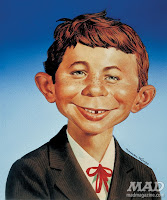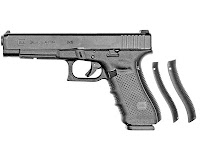As promised, two in one week. Both with clever titles.
So, want to know an easy way to boost the hits on your website or Twitter account? Post a sentence along the lines of this…
Wakko slammed a fresh clip into his pistol and got back to spraying lead across the street.
Yes, as usual here, there’s a catch.
At the risk of angering a lot of folks… If I ever feel the need to correct someone about this, I’m probably not a good writer. Seriously. I would say nine times out of ten when I see other would-be-writers make this complaint…they’re wrong.
(And I say would-be because that does seem to be where a good three-quarters of the comments come from—newbies intent on explaining to established writers where they messed up)
Now, I’m sure a few folks are already leaping down to the comments to tell me I’m wrong. There is a difference between a magazine and a clip. And it matters!
To those people I have one thing to say.
You heard me.
Remember Bob Ross, the happy painter on PBS with the bushy hair? Even if you never actually saw his show, he’s such an iconic part of Americana you probably know him. Heck, it wouldn’t surprise me if there’s a large number of people outside the US who can identify him.
Bob Ross could paint a gorgeous landscape in under half an hour and make it look easy. He did it with an array of paints, a few specialized tools, and maybe six or seven different brushes.
Name three of them.
Any three brushes he used. Or any painter uses. Go.
I’m sure a lot of you thought of the fan brush. Then maybe smiled and thought of the happy brush. Maybe… wasn’t there an angled one, like a… a wedge, or something?
But even then… their actual names? No clue.
That’s not really surprising, of course. I’m willing to bet most of us here have never done more than dabble in painting. It’s not our field of specialty, so we don’t know a lot of the specific terms. We just know the brushes on sight or maybe by the names we’ve given them or heard a few times. Like the happy brush.
In a similar manner, if my characters don’t know anything about weapons, it wouldn’t be unusual for them to not understand the difference between a magazine and a clip (or between a Sig and a Glock, or a broadsword and a longsword, or…). They’d just go off what they remember from television and movies, or maybe some novels they read. Sure, Yakko the former black ops guy would know, but Wakko the homemaker? Odds are, he’s going to call that thing full of bullets a clip. Just like Mr. T did on The A-Team.
Y’see, Timmy, all those people muttering about magazines vs. clips—they’re not wrong about terminology. They’re just focused on the wrong thing (one might even say it’s an empathy issue). The important question here is not which term is factually correct, it’s which term should be used in my story, We’re not writing textbooks, after all, we’re writing fiction. And one of the bigger lessons to learn in fiction is that sometimes my characters will get things wrong. They’re not going to know everything. Because characters who know everything tend to be very boring and wooden.
If I had to guess why some people get so adamant about this—and I’ll try to tread lightly here—I’d think it’s because firearms are a divisive subject. They tend to divide people politically, ethically, and even socially. And this can cloud a writer’s view of things in both directions. Some folks don’t want to make a stupid libtard mistake. Others don’t want to listen to some crazy, overbearing gun nut.
But, as I mentioned earlier this week, this isn’t the real world—it’s fiction. If I want to keep my point of view consistent, I’m going to have some characters who load their pistols with clips. Maybe a lot of them. And, yes, also some who know it’s called a magazine.
Next time, I’d like to keep talking about characters and gunslingers a bit by talking about bulletproof people.
Until then, go write.







